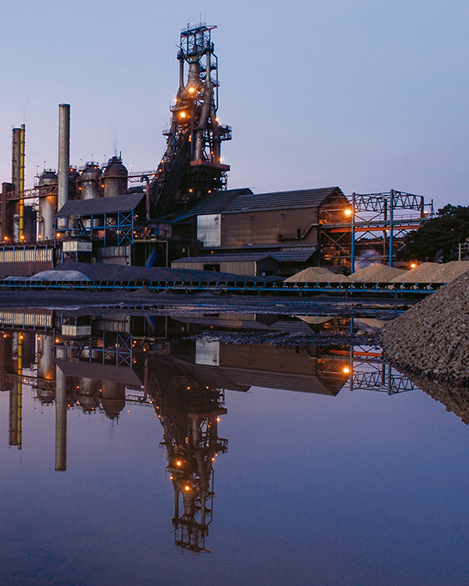Given the diversity and magnitude of its processes, the CAP Group generates residues in large quantities and with very different characteristics. CAP intends to recycle or reuse the residues resulting from each of its company operations or to add value by marketing them.

The growth of economic activity and consumption has increased Chile’s total waste generation, nowadays generating 17 thousand tons of waste per year; of which, less than 10% is recycled. Industrial waste and municipal solid waste have increased at a rate of 3% per year during the last 15 years.
In 2016, Chile enacted the Extended Recycling & Liability Act, which aims to reduce waste generation in the country and increase recycling rates so that at least 30% of all future waste is recycled. This law seeks to formalize an industry of recycling in Chile, taking responsibility to manufacturers and importers of six priority products (producers of lubricating oils, electrical and electronic equipment, batteries, containers and packaging, vehicle tires and batteries) of organizing and funding the recovery of the waste generated by their respective products.

The CAP group generated a total of 436 thousand tons of waste in 2016. 97% of such waste were recycled or reused and 3% (14,345 tons) were disposed in a safe final destination.
CAP Acero, which generates the largest volume of waste, recycles 98% of all that is generated. A large part of such waste is marketed as byproduct. Part of them are generated by the Coking Plant and the Blast Furnace (slag from blast furnaces, fine coke fines, fine ore, blast furnace dusts and sludge), and another part in steel-making and continuous casting (fine lime, slag and steel mill sludge, lamella).
Similarly, mine tailings are recycled (from copper and iron ore mining operations) through the Magnetite Plant. In 2016, 5.1 million tons of mine tailings were thus recycled.
In the case of Cintac, progress was made in managing and registering the tailings generated, reaching a rate of 86%. This figure far exceeds the 33% mark of the year of 2015; all of which was partly attributable to a new mechanism for measuring recycled tailings.
CAP’s corporate building in Santiago joined the Zero Waste Strategy and began, in July 2016, a program for separating waste and recycling it properly. It includes all kinds of cellulose and PET plastic bottles, reaching more than 2,000 kg of material recovered and recycled.
deslice
| Minería | Acero | Procesamiento11 | Infraestructura12 | |||||||||
|---|---|---|---|---|---|---|---|---|---|---|---|---|
| Hazardous waste (tonnes) | 2,319 | 1,251 | 545.4 | 20.2 | ||||||||
| Non-hazardous waste (tonnes) | 2,456 | 424,481 | 3,516 | 8.8 | ||||||||
| Total waste | 4,775 | 426,144 | 4,062 | 35.5 | ||||||||
| % % Recycled/reused waste | 17% | 98% | 83% | 0% | ||||||||
11Procesamiento include Cintac, do not include TUPEMESA, or TASA.
12Infrastructura include only the desalination plant.
CAP’s mining iron ore production tailings are inert and harmless. For this reason, the company dumps the tailings from its pellet plant into the sea, in compliance with all the environmental legislation. In 2016, it generated 5.9 million m3 of tailings. In addition, mining generates liquid residues. In 2016 it generated 7.1 million m3 of such residues.
CAP Acero, which treats its industrial waste, deposits its discharges outside the coastal protection zone, pursuant to the DS90 that requires high standards of measurement discharged waters. In 2016, it generated 49.4 million m3 of such industrial waste.
CAP infrastructure also dumps into the sea the effluents resulting from its operations: more than half of the water extracted is returned to the sea, i.e. about 10.5 million m3.
Cintac generated 94 thousand m3 mainly at the Lonquen Plant, they are subsequently shipped to a water treatment plant of a sanitary company.
The CAP group companies have implemented environmental monitoring programs.
deslice
| Minería | Acero | Procesamiento | Infraestructura | |||||||||
|---|---|---|---|---|---|---|---|---|---|---|---|---|
| 2014 | 2015 | 2016 | 2014 | 2015 | 2016 | 2014 | 2015 | 2016 | 2014 | 2015 | 2016 | |
| Effluents thousands of m3 | n.i. | n.i. | 7,193 | 45,524 | 48,055 | 49,399 | 45 | 59 | 94 | n.i. | 11,301 | 10,533 |
| Tailings thousands of m3 | n.i. | n.i. | 5,987 | No aplica | No aplica | No aplica | ||||||
The purpose of this seminar (held in the Municipality of Huasco in December 2016 within the framework of CAP Mineria’s participation in the Council of Social and Environmental Recovery) was to disseminate scientific evidence regarding the underwater disposal of tailings at the global level. Among the international exhibitors were Dr. Tracy Shimmield, Co-Director of England geological research center, and the Msc. Craigt Vogt, current consultant of the International Maritime Organization, who served for 37 years in the United States Environmental Protection Agency. Among the international speakers were: Dr. Tracy Shimmield, Co-Director of England’s Geological Research Center, and the Msc. Craigt Vogt, current consultant of the International Maritime Organization (IMO), who served for 37 years in United States Environmental Protection Agency (US/EPA).